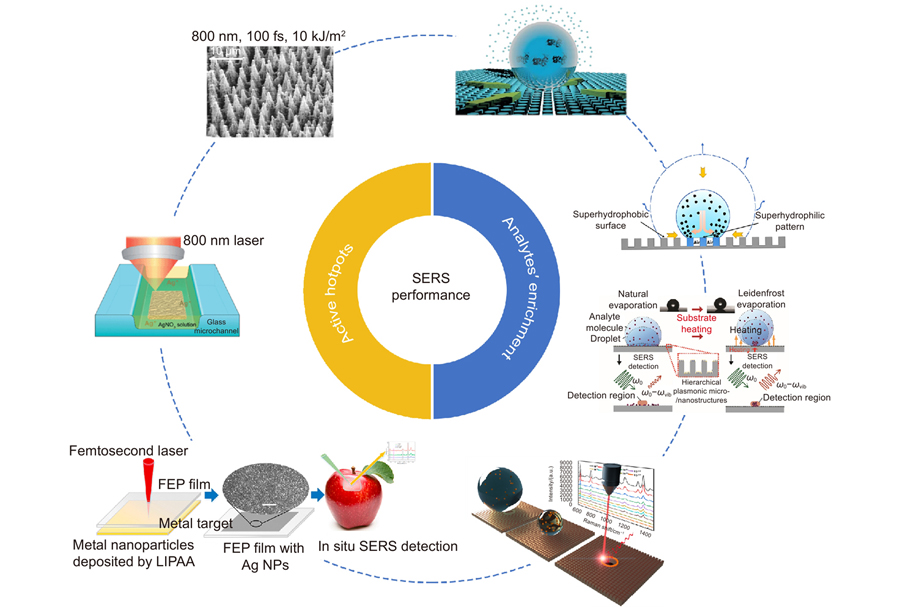光电工程, 2023, 50 (3): 220333, 网络出版: 2023-05-04
超快激光制造表面增强拉曼散射传感器
Ultrafast laser fabrication of surface-enhanced Raman scattering sensors
超快激光加工 拉曼光谱 表面增强拉曼散射 微纳结构 ultrafast laser fabrication Raman spectroscopy surface-enhanced Raman scattering micro/nano-structures
摘要
Overview: Surface-enhanced Raman scattering (SERS) affords a rapid, highly sensitive, and nondestructive approach for label-free and fingerprint diagnosis of a wide range of chemicals. This technique has been applied in explosives detection, pre-cancer diagnosis, food safety, and forensic analysis, where a small number of hazardous substances can seriously affect health of human beings. Thus, it is of great significance to prepare high-performance SERS sensors. In general, the signal intensity of SERS is determined by the following three factors: 1) The enhancement effect of surface nanostructure on local electric fields; 2) The number of molecules to be detected in hot spots; 3) Performance of the Raman spectrometer. Therefore, in order to achieve high-performance SERS detection of trace molecules, current research focuses on how to increase the density of hot spots and the number of analyte molecules in the detection area. An ultrafast laser has an ultra-short pulse width and ultra-high peak power, so it can interact with the majority of materials with high processing accuracy and excellent controllability. Meanwhile, it can rapidly construct a variety of large-area micro/nano-structures on material surfaces based on facile digital programming strategies. In addition, combined with multi-beam parallel fast scanning technology, low-cost and high-efficiency machining can be realized without a special requirement for the machining environment. Based on the above advantages, the ultrafast laser has become one of the important means for the fabrication of micro/nano-structures. This is important for the commercial preparation of high-performance SERS sensors. In this paper, we focus on two aspects to introduce the ultrafast laser preparation of high-performance SERS sensors, including how to increase the density of hot spots and the number of analyte molecules in the detection region. Ultrafast lasers can prepare micro/nano-structures with local field enhancement effects by both "bottom-up" and "top-down" processing strategies. The first is based on the "bottom-up" principle, where the reduction, deposition or polymerization of atoms, molecules or other nanoparticles is controlled by ultrafast lasers to achieve additive manufacturing of micro/nano-structures. The other is based on the "top-down" principle, where materials are removed by the ultrafast laser ablation to rapidly achieve hierarchical micro/nanostructures. These structures provide abundant active hot spots for SERS detection. In particular, the superhydrophobic surfaces prepared by the ultrafast laser are one of the most effective methods to achieve the enrichment of analyte molecules. Raman scattering can be excited more effectively by enriched molecules, which is conducive to obtaining higher detection limits and realizing ultra-trace detection. Finally, a prospect for the development of laser-prepared SERS substrates is provided.
Abstract
Surface-enhanced Raman scattering (SERS) provides important applications in diverse fields. In order to achieve high-precision SERS detection of trace molecules, current research focuses on how to increase the density of hot spots and the number of analyte molecules in the detection area. An ultrafast laser can rapidly construct large-area micro/nano-structures on material surfaces. It is important for the commercial preparation of high-performance SERS sensors. In this paper, the ultrafast laser preparation of high-performance SERS sensors is introduced from the aspect of the density of hot spots and the number of analyte molecules in the detection region. Ultrafast lasers enable both "bottom-up" and "top-down" processing. In particular, the superhydrophobic surface prepared by the ultrafast laser is one of the most effective methods to achieve the enrichment of analyte molecules. Finally, a prospect for the development of laser-prepared SERS substrates is provided.
余建, 杨焕, 吴建根, 吴宜翔, 徐凯臣. 超快激光制造表面增强拉曼散射传感器[J]. 光电工程, 2023, 50(3): 220333. Jian Yu, Huan Yang, Jiangen Wu, Yixiang Wu, Kaichen Xu. Ultrafast laser fabrication of surface-enhanced Raman scattering sensors[J]. Opto-Electronic Engineering, 2023, 50(3): 220333.




